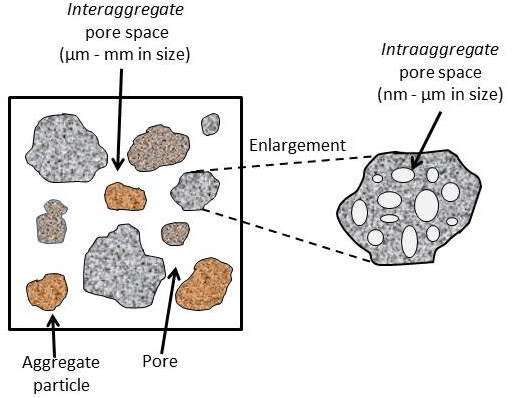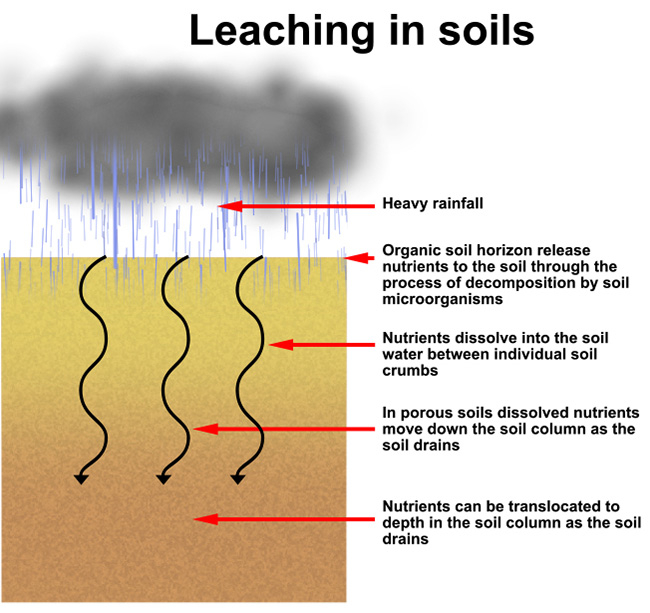土壌中の水分の定量
English
Share
Overview
ソース: ドクターペッパー イアン博士チャールズ Gerba – アリゾナ大学所
示す著者: ブラッドリー ・ シュミッツ
土壌は通常「土壌含水率」として表現することができます水の有限な量を含む土壌団粒 (骨材間の気孔スペース) の間に空隙内および土壌団粒 (内集計気孔スペース) 内で、この水分が存在する (図 1)。通常この気孔スペースは、空気や水によって占められています。すべての毛穴が空気によって占有されて、土は完全に乾燥です。すべての毛穴には水が入り、土は飽和するといいます。

図 1。土の気孔スペース。
Principles
屋外の自然環境に水は、降雨や植物の意図的な灌漑によって土壌に追加されます。いずれにしても、土壌水分はにつれてより毛穴が空気を犠牲にして水でいっぱいになった。すべての毛穴が水でいっぱいになって、余分な水分は雨または潅漑の消滅まで下方 (図 2) 継続的な土壌の気孔を通してを濾す今。溶出は、孔内水膜は、重力の力に対して土壌コロイドの表面張力によって保持されてまで続行されます。このような状況は、土壌水分に関して「容量のフィールド」で土壌と呼ばれます。フィールドの容量で土壌には土壌水分の膜に囲まれた、空気で満たされて毛穴。通常フィールドの容量で土壌は空気と水の両方が使用できるので、植物の成長と好気性土壌微生物に最適です。一方、飽和土は植物を殺すことができ刺激的な嫌気性微生物中の好気性土壌微生物を抑制する水浸しの嫌気的条件を作成します。

図 2。土壌に溶出する栄養素。
ビーカーなどのコンテナー内にある湿った土のサンプルを検討してください。湿った土の重量は、乾燥した土粒子の重量に加えて、土壌内の水の重量で構成されています。土により多くの水を追加すると、土の湿潤重量は増加します。サンプル内の土壌粒子の乾燥重量は、すなわち、1 つの重量は乾燥重量である固定されています。対照的に、土にどのくらいの水を加えに応じてウェットの重みの無限の数があります。このため、土壌、実験演習を行うとき土の含水率は、乾燥重量は一定時間、湿った、またはぬれた重量を時間をかけて変更できますので乾燥重量ベースで、通常表されます。土壌の栄養成分など実験の結果を表現する、乾燥重量ベースの使用は、最終結果の標準化を提供します。
Procedure
Results
Calculate the soil moisture content for each of the replicate samples using the following equation:
% moisture content (MC) = 
(dry wt. basis)
Example Calculations:
M = 102 g
D = 90 g
∴ % MC = 
MC = 13.3%
With the addition of 5 g of water, new M = 107 and D still equals 90
∴ % MC = 
New MC = 18.9%
Applications and Summary
Knowledge of the moisture content of a soil on a dry weight basis is useful in a number of ways. For example, if the experiments are conducted with soil that should be amended with a known concentration of ammonium fertilizer (for example 50 μg/g), then the moisture content on a dry weight basis must be determined. If the calculation was completed on a wet weight basis, the amount of fertilizer to be added would depend on the moisture content (and therefore the moist weight) of the soil sample. Likewise, if potted plants are considered, the moisture content must be known in order to make sure that the soil isn’t too dry (not enough moisture for plant growth) or too wet (waterlogged and anaerobic). In a field situation, knowledge of the soil moisture content can prevent excess irrigation and leaching of soil nutrients.
Transcript
The amount of water held in soil is an important component of biological and ecological processes, and is used in applications such as farming, erosion prevention, flood control, and drought prediction.
Soils typically contain a finite amount of water, which can be expressed as the soil moisture content. Moisture exists in soil within the pore spaces between soil aggregates, called inter-aggregate pore space, and within pores in the soil aggregates themselves, called intra-aggregate pore space. If the pore space is occupied entirely by air, the soil is completely dry. If all of the pores are filled with water, the soil is saturated.
The measurement of the amount of water held within the soil, or the soil moisture content, is essential to the understanding of soil characteristics and the types of plants and microorganisms that reside in it.
This video will introduce the basics of soil moisture content, and demonstrate the procedure for determining moisture content in the laboratory.
In outdoor environments, water is added to soil naturally through rainfall or deliberately with the irrigation of plants. As the pores in the soil become filled with water at the expense of air, the soil moisture increases. When all of the pores are filled with water, the soil is saturated. If the soil at the surface is saturated, excess water will leach downward through pores into deeper soil. Leaching continues until there is not enough water to saturate all of the pore space. At this point pores contain some air and thin films of moisture. The water films within the pores are held by the surface tension of soil colloids, thus water stops leaching.
After leaching stops, and excess water has drained from the soil, the soil is described as being at field capacity. Soil at field capacity has pores that are partially filled with air, surrounded by films of moisture. Soil at field capacity is optimal for plant growth and aerobic soil microorganisms, since both air and water are available. In contrast, saturated soil, where all pores are filled with water, will create an anaerobic environment that can kill plants and suppress aerobic soil microbes.
The mass of moist soil consists of the mass of the dry soil particles, plus the mass of the water within the soil. The dry mass of the soil particles is fixed, whereas the amount of water within moist soil can vary. Therefore, moisture content is calculated on a dry basis, rather than a total mass basis, to ensure consistency. The moisture content of soil is described as the ratio of the mass of water held in the soil to the dry soil. The mass of water is determined by the difference before and after drying the soil.
The following experiment will demonstrate how to measure soil moisture content in the laboratory using these principles.
To begin, collect soil samples and transfer them into the laboratory. Samples of soil can be collected in the field using a soil auger, or a trowel. Use of a soil auger allows for the soil to be sampled to specific depths. Transfer them into the laboratory. Weigh two aluminum dishes, and accurately record the weight of each dish. Aliquot approximately 20 g of the moist soil into each aluminum dish, then reweigh the dish. Subtract the weight of the empty dish from the full dish to acquire the moist soil weight.
Next, dry the soil overnight in an oven set to 105 °C. On the next day, carefully remove the soil samples from the oven using tongs. Place the soil samples on the bench top to cool. When the dry soil samples are cool, reweigh them and record the total weight. Subtract the weight of the aluminum dish, and record the dry soil weight.
Calculate the moisture content of the soil by subtracting the weight of the dry soil from the weight of the moist soil, and then dividing by the weight of the dry soil.
Although the measurement is simple, it is important to determine soil moisture content in order to better understand soil characteristics.
Soil moisture content plays a large roll in environmental concerns, especially when considering soil runoff that may contain fertilizers and pesticides. In this example, soil runoff was analyzed using a simulated rainfall study in order to determine the retention of a compound in moist soil.
Soil, containing urea, was packed into soil boxes and assembled under a rainfall simulator. Soil runoff was collected, and the concentration of urea in the runoff water calculated. The amount of urea in the soil runoff was higher for soils that had higher moisture content, indicating that urea is better absorbed in drier soil, than in moist.
The fate of chemicals in soil can also be analyzed by direct pore water sampling, using a lysimeter, as shown in this example. In this experiment, lysimeters, or long metal tubing, were installed in soil with turf grass to analyze pore water in vegetative soil.
The pore water sampler was then installed, and water pumped from the lysimeter after applying chemicals to the soil. The collected water was then analyzed, and the concentration of applied chemicals correlated to soil depth and moisture content.
The results demonstrated that the concentration of the herbicide monosodium methyl arsenate, or MSMA, was the highest in the top 2 cm of soil.
You’ve just watched JoVE’s introduction to soil moisture content. You should now understand how to accurately measure soil moisture content in the laboratory. Thanks for watching!




